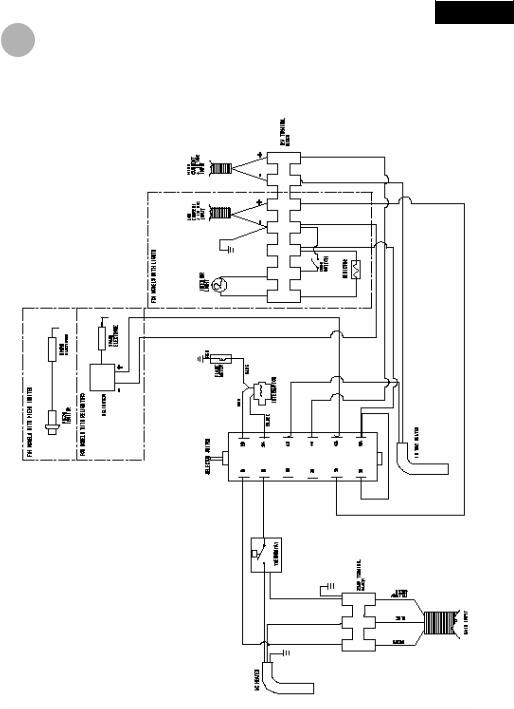Thetford N145 User Manual [fr]

Thetford Refrigerators (After Market)
FIGURES FOR INSTALLATION 2 |
|
|
|
||
UK |
Installation |
11 |
NL |
Installatie |
41 |
FR |
Installation |
19 |
IT |
Installazione |
50 |
DE |
Einbau |
27 |
SE |
Montering |
60 |
ES |
Montaje |
35 |
|
|
|
628442 / 0408

1. |
FIGURES |
|
A |
B |
C |
D |
E |
F |
G |
H |
I |
J |
|
|
|
|
|
|
|
|
|
|
|
|
|
|
Gross |
Net |
|
|
|
|
|
|
|
|
Dimensions |
volume |
volume |
Volume |
Input * |
Input * |
Net |
|
|
|
Model |
H x W x D (mm) |
incl. |
incl. |
freezer |
weight |
Operation |
Ignition |
|||
(kWh/24h) |
(gr./24h) |
|||||||||
|
Depth incl. door |
freezer |
freezer |
(L) |
(kg) |
|
|
|||
|
|
|
|
|
||||||
|
|
(L) |
(L) |
|
|
|
|
|
|
|
N80 – |
|
|
|
|
|
|
|
Manual |
Piëzo |
|
821 x 486 x 543 |
81 |
75 |
10 |
2.5 |
300 |
22 |
Energy |
|||
N10F 01x1P |
(Manual) |
|||||||||
|
|
|
|
|
|
|
Selection |
|||
|
|
|
|
|
|
|
|
|
||
|
|
|
|
|
|
|
|
|
|
|
N100 – |
|
|
|
|
|
|
|
Electric |
|
|
821 x 525 x 543 |
97 |
91 |
11 |
2.8 |
330 |
29 |
Energy |
Electric |
||
N31G02x6E |
||||||||||
|
|
|
|
|
|
|
Selection |
|
||
|
|
|
|
|
|
|
|
|
||
|
|
|
|
|
|
|
|
|
|
|
N145 – |
|
|
|
|
|
|
|
Smart |
|
|
1245 x 525 x 543 |
141 |
138 |
23 |
4.0 |
420 |
38 |
Energy |
Automatic |
||
N51H06x6A |
||||||||||
|
|
|
|
|
|
|
Selection |
|
||
|
|
|
|
|
|
|
|
|
||
|
|
|
|
|
|
|
|
|
|
|
N180 – |
|
|
|
|
|
|
|
Smart |
|
|
1245 x 525 x 603 |
180 |
175 |
11 |
3.7 |
400 |
39 |
Energy |
Automatic |
||
N60H09x6A |
||||||||||
|
|
|
|
|
|
|
Selection |
|
||
|
|
|
|
|
|
|
|
|
||
|
|
|
|
|
|
|
|
|
|
|
|
|
|
|
|
|
|
|
|
|
|
A |
B |
C |
D |
E |
F |
G |
H |
I |
J |
|
|
|
Gross |
Net |
|
|
|
|
|
|
|
|
Measurements |
volume |
volume |
Volume |
Input ** |
Input ** |
Net |
|
|
|
Model |
H x B x D (mm) |
incl. |
incl. |
freezer |
weight |
Operation |
Ignition |
|||
(kWh/24h) |
(gr./24h) |
|||||||||
|
depth incl. door |
freezer |
freezer |
(L) |
(kg) |
|
|
|||
|
|
|
|
|
||||||
|
|
(L) |
(L) |
|
|
|
|
|
|

FIGURES
2.
3. |
|
4. |
|
|
|
5.
3

FIGURES
6.
7.
8.
4

FIGURES
9.
10
N145 / N180
5

FIGURES
11
N100 / N180 |
|
N80 |
|
|
|
12
.
Model |
H |
W |
D |
Hst |
Dst |
|
|
|
|
|
|
N80 |
825 |
490 |
515 |
220 |
235 |
|
|
|
|
|
|
N100 |
825 |
529 |
515 |
- |
- |
|
|
|
|
|
|
N145 |
1250 |
259 |
515 |
- |
- |
|
|
|
|
|
|
N180 |
1250* |
529 |
540 |
- |
- |
|
|
|
|
|
|
* Incl. protruding latch: 1265 mm
6

FIGURES
13. |
|
14. |
|
|
|
15. |
|
16. |
|
|
|
7

FIGURES
17
8

FIGURES
18
9

FIGURES
19
10

UK
CONTENTS |
|
|
1. |
INTRODUCTION |
12 |
2. |
SAFETY INSTRUCTIONS |
12 |
3. |
DETERMINING WHERE TO IN STALL THE REFRIGERATOR |
13 |
4. |
OUTSIDE VENTS |
14 |
5. |
COMBUSTION GASES OUTLET |
15 |
6. |
REFRIGERATION INSTALLATION |
15 |
7. |
ELECTRICAL COMPONENTS |
16 |
8. |
GAS CONNECTION INSTALLATION |
18 |
9. |
WIRING DIAGRAMS |
18 |
11

UK
1.INTRODUCTION
This installation manual concerns the The tford absorption refrigerators for the After Market. This manual serves as a guide for the correct and safe installation of the refrigerator. Thetford refrigerators are a category C11 (EN 1749) product: “appliances with gas as energy source and which need to be installed isolated from the living area”.
Read this installation manual carefully before installing the refrigerator. Referrals to explanatory illustrations at the beginning of this manual are common.
1.1 Application
This appliance has been designed for use in car avans and motor homes . When installing in any other vehicle, comply with the requirements set for that particular vehicle.
1.2 Technical data
Category |
C11* |
|
AC |
230V (50/60 Hz) |
|
DC |
12V |
|
Gas type |
I3+ (G30: 28-30/G31: 37 mbar)* (Countries: BE, FR, IE, LU, PT, ES, GB, GR, |
|
|
IT) I3B/P (G30/G31: 28-30 mbar)* |
(Countries: DK, DE, IS, NL, SE, FI, |
|
NO) (G30 = Butane , G31 = Propane) |
|
*EN 732 specifications for liquid gas appliances – Absorption refrigerators
1.FIGURE 1: Specifications of other refrigerator models
A |
B |
C |
D |
E |
F |
G |
H |
I |
J |
|
|
Measurements |
Gross |
Net |
Volume |
|
|
Net |
|
|
|
Model |
volume |
volume |
Input ** |
Input ** |
Operation |
Ignition |
||||
H x B x D (mm) |
incl. |
incl. |
freezer |
weight |
||||||
(kWh/24h) |
(gr./24h) |
|||||||||
|
depth incl. door |
freezer |
freezer |
(L) |
(kg) |
|
|
|||
|
|
|
|
|
||||||
|
|
(L) |
(L) |
|
|
|
|
|
|
** average energy use at a surrounding temperature of 25ºC and with proper installation
2.SAFETY INSTRUCTIONS
2.1Alerts
The following alerts are used in this manual:
“Warning” indicates harm to the product or installer if the installer fails to carry out the described procedures carefully. Non-observance may result in serious injury to the installer or damage to the product.
“Guideline”, points at a condition that needs to be taken into account during installation.
“Important ” denotes supplementary information for the installer and alerts the installer to potential problems.
“Recommended”, this situation is partially recommended.
“Discouraged”, this situation is partially discouraged .
“Prohibited”, this situation is not to occur.
12

UK
2.2Warnings
-Install the refrigerator in accordance with the manufacturer’s instructions and local/national laws.
-Incorrect installation or maintenance of the refrigerator may cause physical injury and/or damage to the refrigerator.
-Never use naked flames whilst performing maintenance or repairs on gas lines or when
checking fittings for leaks. Gas may ignite and cause an explosion resulting in serious physical injury and/or damage to the product.
-Never reposition or change the electronic or gas components or parts.
-Never open or damage the cooling device at the rear of the refrigerator. The cooling system is pressurized and contains substances harmful to health.
-There are sharp edges and corners at the rear of the refrigerator. Always wear protection against cuts when installing the refrigerator.
-Install the refrigerator somewhere completely isolated (insulated) from the living area of the caravan or motor home. Air for the burner must not be drawn from the living area of the caravan or motor home and combustion gases must not enter the living area. Combustion gases may contain carbon monoxide. Inhalation of this gas may cause tightness of the chest, dizziness and can lead to death.
-Never expose the refrigerator to water or moisture.
-To cool the system and to supply the burner with a sufficient airflow, m ake sure that there is always sufficient ventilation through the outside vents.
-A qualified installation engineer must install the refrigerator.
-The refrigerator and its extractor must be installed in a way that allows easy access for maintenance and repairs.
-The installation and connections must satisfy the most recent technical regulations.
-The refrigerator is designed for powering by liquid gas (butane and propane), 12V DC or 230VAC.
-The performance of the refrigerator may be affected by adjacent heat sources such as an oven or stove. Protect the refrigerator against any heat source by fitting insulation.
3.DETERMINING WHERE TO INSTALL THE REFRIGERATOR
Various possibilities exist for positioning the refrigerator in a caravan or motor home. However, the refrigerator’s performance depends on good ventilation. Ventilation takes place through two gratings in the wall of the caravan or motor home. When deciding where to position the refrigerator, you must take into account the best place for positioning the ventilation gratings.
Always make sure that the ventilation gratings can never be blocked. Blocked gratings reduce the supply and extraction of air. An insufficient air supply can result in incomplete combustion and the forming of carbon monoxide. Insufficient air extraction can also reduce the refrigerator’s cooling performance.
2.FIGURE 2: The perfect installation situations occur when the outside vents cannot be covered by e.g. doors.
3.FIGURE 3: When the refrigerator is installed next to the caravan or motor home entry, it is imperative that the door, when open, does not block the ventilation gratings. Allow at least a 25 mm distance between the ventilation gratings and the door.
4.FIGURE 4: In this situation, combustion gases may enter the living area. Such installation situations are thus not recommended.
13

UK
4 VENTILATION
Perfect ventilation is very important to ensure the cooling system works properly. Heat is generated in the cooling system. The heat must be able to escape into the open air. Cold air extraction is necessary to allow the cooling system to cool down again and to maintain the circulation of air.
5.
FIGURE 5: The refrigerator is ventilated by means of two openings in the wall of the caravan or motor home across which ventilation gratings are placed. Cold air comes in through the lower grating. The cooling system heats the cold air and it takes out again through the upper grating (chimney effect).
4.1Installation ventilation gratings
-Install the ventilation gratings exactly as described in this manual.
Any other method of installation will invalidate the manufacturer’s warranty for the refrigerator.
- Always fit the ventilation gratings at the rear of the refrigerator. Fitting them at the side will reduce the refrigerator’s cooling capacity.
6.FIGURE 6: The lower ventilation grating
The lower ventilation grating should preferably be positioned behind the burner
box and the power board. This grating is also used for access during periodical Maintenance and repairs to the refrigerator.
At the bottom of the combustion area there must be a hole in the floor. If a gasleak occurs this hole will allow gas (which is heavier than air) to stream outside instead of building up on the floor. For this purpose there should be a hole in the floor which leads directly outside, with a diameter in conformity with local regulations, but we advice a diameter of at least Ø40 mm.
If it is not possible to make a hole in the bottom, it is possible to make a proper installation by positioning the bottom of the lower ventilation grating lower than the burner box. In this way the gas has the possibility to escape through the grating before reaching the burner flame. However might mean that the refrigerator will have to be removed from the vehicle in case of maintenance or repair of the burner box or powerboard.
7.FIGURE 7: The upper ventilation grating
The installation of the upper ventilation grating influences the cooling capacity. The best result is achieved when this grating is installed as far above the condenser as possible. For Thetford small vents use at least 110 mm distance between the top of the refrigeration cabinet and the top of the ventilation cut-out. Situation [1] is the preferred installation procedure for small vents and creates there the optimal cooling capacity. Situation [3] is the preferred installation procedure for large vents and creates there the optimal cooling capacity. Situation [2] is without a ventilation grating at the topside of the fridge, but with a chimney on the roof, which is also a possibility.
4.2Installation ventilation gratings
8.
FIGURE 8: A ventilation system compromises of two sets of a vent frame [A], a vent screen [B], and a vent outer [C]. The large vents do not have a vent screen [B]. To install the ventilation gratings, make, using the templates provided, a horizontal rectangular recess in the wall of the caravan or motor home..
1.Use the accompanying template to cut out the ventilation recess.
2.Seal the vent frame [A] in a watertight way by means of sealant or butyl tape.
3.Only for the upper ventilation grating a small vents: assembly the vent cap [E] together with the vent frame.
4.Position the vent frame [A] in place.
5.Place the vent screen [B] in the vent frame (only for small vents).
6.Place the vent outer [C] over the vent frame[A] and fasten it with the two retaining slides.
14

UK
5.EXTRACTION OF COMBUSTION GASES
-The air for the burner must not come from the living area of the caravan or motor home and combustion gases must not enter the living area. The refrigerator must therefore be installed in a place completely separated (insulated) from the living area of the caravan or motor home.
-The fully installed refrigerator must allow the proper and complete discharge of combustion gases. Combustion gases may contain carbon monoxide. Inhalation of this gas may cause tightness of the chest, dizziness and can lead to death.
-The refrigerator is designed for powering by liquid propane gas, butane gas or a mixture.
-A qualified person must install gas components.
-The gas components must be installed in accordance with the latest technical regulations.
-Combustion gases must always be discharged upwards.
-The exhaust of the refrigerator must be installed so that it is always accessible for maintenance and repairs.
5.1Installing the flue exhaust system
9.FIGURE 9: The flue cap [E] has to be assembled together with the vent frame [A]. The exhaust tube [F] takes care of transporting the exhaust fumes and created heat outside the combust ion area. The outlet of the exhaust tube has to be close to the bottom-side of the vent . By rotating (see arrows) the exhaust tube and sliding it over the flue [G] you can adjust it so that the outlet of the exhaust is in the position as shown in the drawing below .
-It is important to always keep a distance of 5mm minimum from the vent!
-The outlet of the exhaust tube has to be close to the bottom-side of the vent.
-When positioned correctly, use the clamp to fix the exhaust tube to the flue of the refrigerator.
For refrigerator model N145 and N180 only:
You do not need to install a separate extractor. The combustion gases will automatically be extracted properly via the upper ventilation grating after installation of the refrigerator.
10.FIGURE 10: Check that the minimum distance between the cover and the sides of the caravan or motor home is at least 1 cm. Make sure that the closed side of the cover faces the refrigerator.
6.INSTALLING THE REFRIGERATOR
-The air from the burner must not come from the living area of the caravan or motor home and combustion gases must not enter the living area. The refrigerator must be installed in a place completely separated (insulated) from the living area of the caravan or motor home.
-The performance of the refrigerator is affected by the way it is installed.
-The performance of the refrigerator may be affected by adjacent heat sources such as an oven or stove. Protect the refrigerator against any adjacent heat source by fitting insulation.
-Make sure the floor is solid and even. The floor must be able to take the weight of the refrigerator with its contents.
6.1Fitting margins
FIGURE 11 / 12: If you use Thetford combustion seals, the dimensions as mentioned in table 11/12
11.are required.
15

UK
6.2Securing the refrigerator
1. FIGURE 13: If you use Thetford combustion seals, these need to be fixed in the way shown in the
13.
drawing to ensure optimum insulation. Fix the upper and lower flap of the combustion seal. Fix the strips to the sides of the refrigerator in a vertical di rection at the rear of the refrigerator. Fix the upper and lower flap of the combustion seal in the way shown in the drawing.
14.FIGURE 14: The refrigerator is installed in the unit using four screw holes on the sides (the N145 models have got six screw holes).
1.Place the refrigerator completely straight in the unit (when the caravan or motor homeis level, the refrigerator should also be level).
2.Put screws through the holes on the inside of the refrigerator and screw it through the wall of the refrigerator into the unit.
3.Place the white caps over the holes.
If the size of the unit is such that the combustion seal fails to seal properly, use a different kind of sealing to keep hazardous combustion gases out of the living area of the caravan or motor home.
6.3Technical drawings
Technical drawings are available for every type of refrigerator. These are precise A1 (scale 1:5) drawings stating all relevant measurements of the refrigerator and its surrounding. If wished for, Thetford is able to send you the technical drawing of your refrigerator model.
6.4Fitting the door panel
15.FIGURE 15: In order to fit the door panel, the refrigerator’s door needs to be demounted. [1] Open the door, unfasten the screw from the top hinge point with a screwdriver and remove the screw. [2] Hold the door at a slight angle and lift the door from the lower hinge pen.
[3]Remove the 3 screws with which the lower cover is attached to the door.
[4]Remove the cover and slide the panel into the holder.
[5]Repeat steps [1] / [2] and [3] in reversed order.
7.ELECTRICAL COMPONENTS
-The electrical connections have to comply with EN 60335-1
-A qualified person must install the electrical connection.
-The electrical components must be in accordance with the latest technical regulations.
-Wiring must be installed so that wires cannot come into contact with hot or sharp parts.
7.1Connecting to the mains (230 V)
-Connecting the 230v cable to a properly earthed power point will increase the safety aspect.
-Make sure the power point is in a position that is easy to reach.
-Position the 230v power lead in such a way that it cannot come into contact with hot or sharp parts.
-The mains connection must be fitted with a 3 A fuse.
-In case of a damaged power lead with one of the SES models (Smart Energy Selection, see figure 1), this must be replaced with a Thetford power lead.
7.2Connecting to a DC power supply (12 V) for piezo and electric models (fig. 1)
These models have two 12V connection points to prevent the battery from being discharge d by the refrigerator when the engine is not running.
16

UK
The high-current power supply (red cable +, white cable -) provides current to the 12V heating element of the cooling system. This connection point may supply 12V only when the engine of the car or motor homeis running.
E Models (Figure 1): the low-current power supply (purple cable +, black cable -) provides a continues current of 12V for ignition of the burner and the light in the refrigerator. The 12V supply is obtained via the connection to the car or motor home battery or via the 230V AC à12V DC transformer.
-Make sure the power point is in a position that is easy to reach.
-Minimize voltage drops by thoroughly fixing the wires.
-Position the 12Vpower lead so that it cannot come into contact with hot or sharp parts.
-In connection with voltage drops in high-power supply, the diameter of the lead depends on the lead length: Leads longer than 6 m à for optimum performance the lead diameter should be 6 mm² (with a minimum of 4 mm²).
-The high -current power supply must be fitted with a 12 A fuse, the low current supply must be fitted with a 1 A fuse.
7.3Connecting to a DC power supply in vehicles with a separate D +/E+ (engine running) signal
The high current connection (HC, red wire +, white wire -) provides current to the DC heater of The cooling system. This connection should be connected to a continues DC supply. Connect the red and the white wire directly without any breakers (e.g.contact) to the vehicle starter battery. This connection is protected on the power board with a 20A fuse.
The low current connection(LC, purple wire +, black wire -) provides a continues current of DC for the power board of the refrigerator. This DC supply is obtained via the connection to the auxilary battery or via the 230V AC àDC transformer. This connection is protected on the power board with a 2A fuse.
The D+ connection (orange wire +) ensures the DC heater can not be switched on (manual or automatic) when the engine of the vehicle is not running.
Connect the D+ connection to a DC connection point that shows that the vehicle’s engine is running (engine running: DC, engine not running: no voltage)
This connection is only used as a signal cable.
-Position the connecting point so that it is easy to reach.
-Make sure that all connections are properly fastened to minimize voltage drops.
-Use wires with a diameter of 10 mm² (with a minimum of 6 mm²) to ensure optimum performance of the refrigerator.
-Position the DC power lead in such a way that it cannot come into contact with hot or sharp parts.
-In connection with voltage drops in high power supply, the diameter of the leads depends of the lead length: Leads longer than 6 m à for optimum performance the
lead diameter should be 6 mm² (with a minimum of 4 mm²).
-In conformity with EN 1648-1/2 the respective negative and positive wires of the DC connections high current and low current can not be connected together.
17

UK
8.CONNECTING THE GAS SYSTEM
-The gas connection has to comply with EN 1949 and EN 732
-Gas components may be installed only by a qualified installer. Be sure to use high -quality approved parts.
-The gas components must be installed in accordance with the latest technical regulations.
-Gas pipes or hoses must be fitted so that they cannot come into contact with hot or sharp parts.
-Keep flammable materials well away from the refrigerator.
-The refrigerator’s gas supply must be fitted with a gas valve that allows the gas supply to be switched off. The gas valve must be readily accessible by the user.
-Make the connections airtight by means of an approved connector in accordance with local regulations.
-If you use a gas hose, make sure it is of an approved type in accordance with local regulations.
-Position the hose in such a way that it is not twisted, cannot turn and cannot buckle.
-A gas hose has a limited service life. Therefore, install the hose in a way that allows its
easy replacement. Check the hole regularly for breaks, cracks, and ageing. Replace the hose if you are in any doubt. Take notice of the maximum life of the hose and replace it on time subject to the limits specified by the manufacturer or local regulat ions.
-Make a hole in the floor at the rear end of the refrigerator (Fig. 6). If a gas leak occurs, this hole will allow the gas to stream outside instead of building up on the floor. This hole must be in conformity with local regulations, but we advice a diameter of at least Ø40 mm. If it is not possible t o make a hole in the bottom, it is also possible to position the
lower ventilation grating at floor level or just below. In this way the gas has the possibility to escape through the grating. However this means that the refrigerat or will have to be removed from the vehicle in case of maintenance or repair of the burner box or powerboard. At places where metal gas lines enter the floor, affix a watertight and airtight rubber ban d around the pipe to prevent vibration and wear.
- Check the gas connection for leaks after the complete installation of the refrigerator.
16
- FIGURE 16: Refer to the type plate on the inside of your refrigerator and to the table at the front of this booklet when choosing a gas type.
- Refer to the type plate on the inside of the refrigerator for the pressure setting of the gas pressure control.
1. WIRING DIAGRAMS
17FIGURE 17: Wiring diagram N80 + N100
18FIGURE 18: Wiring diagram N145
19FIGURE 19: Wiring diagram N180 .
18

FR
SOMMAIRE |
|
|
1. |
INTRODUCTION |
20 |
2. |
CONSIGNES DE SECURITE |
20 |
3. |
CHOIX DE L’EMPLACEMENT D’INSTALLATION DU REFRIGERATEUR |
21 |
4. |
SYSTEME D’AERATION |
22 |
5. |
EXTRACTION DES GAZ DE COMBUSTION |
23 |
6. |
INSTALLATION DU REFRIGERATEUR |
23 |
7. |
COMPOSANTS ELECTRIQUES |
24 |
8. |
BRANCHEMENT DE L’IN STALLATION DE GAZ |
26 |
9. |
SCHEMAS DE CABLAGE |
26 |
19

FR
1.INTRODUCTION
Les présentes instructions d’installation concernent les modèles disponibles en 2ème monte de réfrigérateurs à absorption de Thetford et vous guideront dans une installation correcte et sans risque pour votre réfrigérateur. Les réfrigérateurs Thetford sont des appareils de la catégorie C11 (EN 1749) : “appareils dont le gaz est la source d’énergie et qui nécessitent une installation isolée de la surface de séjour”.
Il est conseillé de lire attentivement les présentes instructions d’installation avant d’installer le réfrigérateur. Il est renvoyé aux illustrations explicatives au début de ce manuel.
1.1 Application
Cet appareil a été conçu pour une d’installation dans tout au tre véhicule, respecter pour ce véhicule.
utilisation en caravanes et camping -cars. En cas il est impératif de se conformer aux exigences à
1.2 Caractéristiques techniques |
|
|
Catégorie |
C11* |
|
AC |
230V (50/60 Hz) |
|
DC |
12V |
|
Type de gaz |
I3+ (G30: 28-30/G31: 37 mbar)* (Pays |
: BE, FR, IE, LU, PT, ES, GB, GR, IT) |
|
I3B/P (G30/G31: 28 -30 mbar)* (Pays |
: DK, DE, IS, NL, SE, FI, NO) |
|
(G30 = Butane, G31 = Propane) |
|
*Spécifications EN 732 pour appareils à gaz liquéfié– Réfrigérateurs à absorption
1.FIGURE 1 : Spécifications d’autres modèles de réfrigérateurs
A |
B |
C |
D |
E |
F |
G |
H |
I |
J |
|
|
Dimensions |
|
|
|
Consom |
|
|
|
|
|
|
|
|
|
mation |
|
|
|
|
||
|
h x l x p |
Volume brut, |
Volume |
Volume |
Consom |
Poids |
|
|
||
|
en |
|
|
|||||||
|
(mm) |
freezer |
utile, freezer |
mation |
|
|
||||
Modèle |
freezer |
électricit |
net |
Opération |
Allumage |
|||||
profondeur |
compris |
compris |
en gaz** |
|||||||
|
(L) |
é** |
(kg) |
|
|
|||||
|
porte |
(L) |
(L) |
(g/24h) |
|
|
||||
|
|
(kWh/24 |
|
|
|
|||||
|
comprise |
|
|
|
|
|
|
|
||
|
|
|
|
h) |
|
|
|
|
||
|
|
|
|
|
|
|
|
|
** consommation moyenne pour une température ambiante de 25ºC et une installation appropriée
2.CONSIGNES DE SECURITE
2.1Pictogrammes
Les pictogrammes suivants sont utilisés dans les présentes instructions :
“Avertissement” signale un dommage pouvan t être causé au produit ou à l’installateur si ce dernier néglige d’observer avec soin les procédures prescrites. Toute inobservation peut se traduire par une blessure grave causée à l’installateur ou par un dommage causé au produit.
“Directive”signale un fait ou un état devant être pris en compte pendant l’installation.
“Important ” annonce des informations complémentaires pour l’installateur et attire l’attention de ce dernier sur des problèmes potentiels.
20

FR
“Conseillé”, cette situation est partiellement conseillée.
“Déconseillé”, cette situation est partiellement déconseillée.
“Interdit”, cette situation est à proscrire.
2.2Avertissements
-Le réfrigérateur doit être installé conformément aux instructions du fabricant et à la législation locale/ nationale.
-Une installation ou une maintenance erronée du réfrigérateur peut entraîner un risque de blessure physique et/ou l’endommagement du réfrigérateur.
-N’utilisez jamais de flammes nues lorsque vous effectuez des travaux de maintenance ou de réparation sur des tuyaux de gaz ou que vous vérifiez l’étanchéité des raccords. Le gaz peut s’enflammer et provoquer une explosion à l’origine de blessures physiques graves et/ou d’un endommagement du produit.
-Le réglage des composants électroniques ou des pièces de l’installation de gaz ne doit jamais être corrigé ni modifié.
-N’ouvrez jamais le groupe frigorifique à l’arrière du réfrigérateur et évitez de l’endommager. En effet, il est sous haute pression et contient des substances nocives pour la santé.
-Veillez toujours à porter des gants de protection pour installer le réfrigérateur dont la partie arrière présente des arêtes et des angles tranchants.
-Installez le réfrigérateur dans un endroit totalement séparé (isolé) de la surface de séjour de la caravane ou du camping-car. L’air nécessaire au brûleur ne doit pas provenir de la surface de séjour de la caravane ou du camping-car et les gaz de combustion ne doivent pas y pénétrer. Les gaz de combustion peuvent contenir du monoxyde de carbone, dont l’inhalation peut entraîner un sentiment d’oppression, des vertiges, voire la mort.
-N’exposez jamais le réfrigérateur à l’eau ni à l’humidité.
-Assurez -vous que les grilles d’aération garantissent une ventilation suffisante pour refroidir le système et approvisionner le brûleur en air frais.
-L’installation du réfrigérateur doit être confiée à un technicien agréé.
-Le réfrigérateur et l’extracteur de gaz doivent être installés de sorte à permettre un accès
aisé pour tous travaux de maintenance et de réparation.
-L’installation et les raccordements doivent être conformes aux normes techniques les plus récentes.
-Le réfrigérateur est conçu pour fonctionner au gaz liquéfié (butane et propane) ou sur secteur 12V DC ou 230V AC.
-Le rendement du réfrigérateur peut être entravé par des sources de chaleur adjacentes, p. ex. four ou réchaud. Prévoyez une isolation pour protéger le réfrigérateur contre toute source de chaleur.
3.CHOIX DE L’EMPLACEMENT D’INSTALLATION DU REFRIGERATEUR
Le réfrigérateur peut être installé à plusieurs endroits dans une caravane ou un camping-car. Cependant, le rendement du réfrigérateur dépend de la qualité de la ventilation, qui est assurée par deux grilles d’aération situées dans la paroi de la caravane ou du camping-car. Le choix de l’emplacement d’installation du réfrigérateur dépend du positionnement optimal des grilles d’aération.
Assurez-vous toujours que les grilles d’aération ne peuvent pas être obstruées. L’obstruction des grilles réduit l’amenée et l’extraction d’air. Une amenée d’air insuffisante peut entraîner une combustion incomplète et la formation de monoxyde de carbone. Une extraction d’air insuffisante peut également réduire la puissance frigorifique du réfrigérateur.
21
